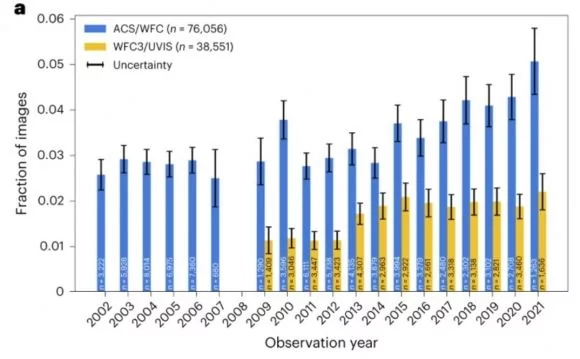Located in low orbit around the Earth, Hubble like the telescopes on the ground, faces an increasing number of its photographs polluted by passages of satellites in its field of vision. A study has observed this impact, limited until now, but which will continue to grow with the rise of superconstellations.
Hubble’s orbit, which is lowering, does not help matters.
Like a faint line on the image…
Surprisingly, even before Hubble was sent into orbit in 1990, researchers had already published a study showing that an increasing number of artificial satellites would cross the field of observation of the telescope, causing frequent loss of results due to their high reflectivity. For 33 years, however, the subject has remained anecdotal or almost: as (almost) everyone knows, the Hubble telescope is an incredible success and its photos shared around the world have advanced science, understanding of the universe and have fascinated the public. But finally, is Hubble from time to time the victim of “streaks”, these luminous traces left by the satellites during long exposure photographs? And if so, how often? A team led by Sandor Kruk of the Max Planck Institute has conducted the survey for the past 20 years. And the first observation is that around 2.7% of the images from the orbiting telescope contain one or more light lines from other satellites. Perhaps more importantly, that number is growing.

The more we expose, the more lines there are
Indeed, it seems that in recent years, the appearances of satellites on Hubble images have reached almost 5% for the ACS/Wide Field Camera instrument (wide field). An increase which is due to two main factors: the spectacular increase in the number of satellites in low orbit, and the drop in Hubble’s orbit. The first symptom is widely followed, in particular by ground-based astronomical observatories and in particular for the case of the Starlink constellation of SpaceX. The latter finds itself again in the spotlight, for a very simple reason, because it has just exceeded 4,000 satellites in orbit. With the OneWeb constellation (544 active satellites) and the other competitors rushing to the gate, several tens of thousands of units will probably be sent into low orbit before the end of the decade.

The risks of passing in front of Hubble increase proportionally, especially since Hubble snapshots are not a matter of seconds. The typical exposure time for an image is 11 minutes… And for deep fields, this can go up to several tens of days. The article, which also explores the software means of restoring the poses degraded by the lines, evokes for the moment unsatisfactory results.
Starlink goes up, Hubble goes down
Hubble is a bit out of luck with the constellations, and with Starlink. When it was sent into orbit in 1990, it was flying at an altitude of almost 550 km, and with each shuttle visit this figure was able to increase a little, to fight against the constant, but inevitable braking generated by the rare atmospheric particles. present around the Earth. Today Hubble evolves below 537 km altitude, which leads it to pass more and more regularly under the layers of Starlink satellites (for OneWeb it was already settled, they are at 1,200 km altitude) .
We better understand NASA’s interest (helped by SpaceX with the private Polaris program) to raise the orbit of the most famous of telescopes!
Source : Universe Today

5